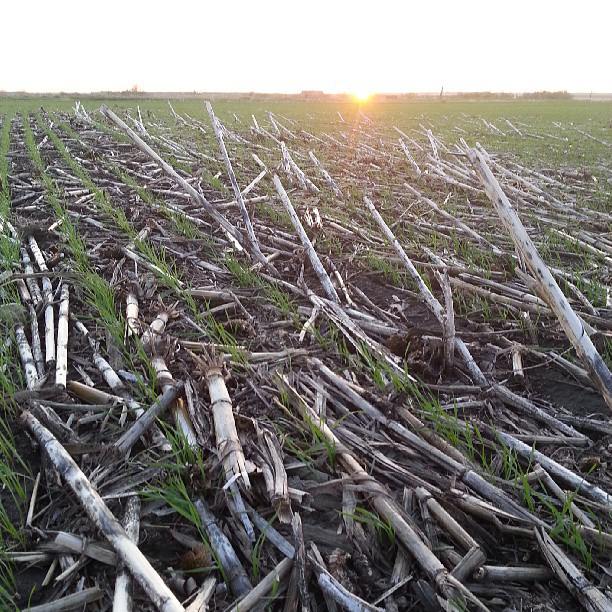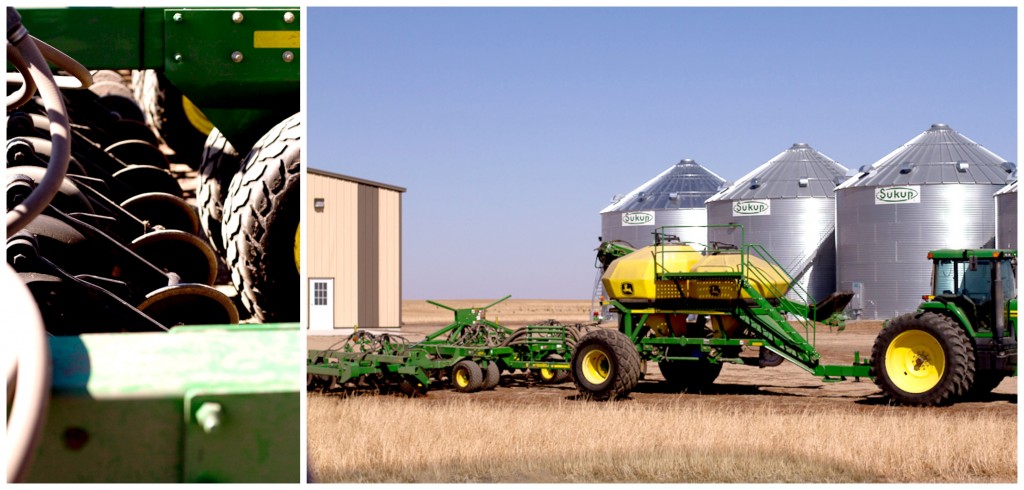
Did you know that two different pieces of equipment are needed for us to get all of our planting done?
Choosing the right piece of equipment for any given farming job is not always easy. Soybean, small grains (like wheat), and corn growers can share many different pieces of equipment. For example, last year during harvest I explained about how we use a combine (or harvester) to get the job done. And no matter what crop you are harvesting, the combine can be used. But when it comes to planting, we use two main pieces of equipment to get our crops in the ground: a grain drill and a planter.
We farm no-till: What is no-till and why does that matter?
The grain drill (or drill) is used to plant (or we call it seed) wheat and soybeans. The planter is used to plant corn and sunflowers. Now before I go into how each piece of equipment works specifically, I want to talk a little about how we farm. We farm using a technique called “no-till”. Rohrich Farms hasn’t always been practicing no-till, it wasn’t until recently in the last two decades that we’ve switched over. So what does no-till farming do for us? Tilling is an extremely effective method to remove weeds as well as shape the soil into rows for crop plants and furrows for irrigation. A true no-till system avoids disturbing the soil with any kind of tool (plows, cultivators, and discs). A plow basically flips over the top layer of soil incorporating nearly all residue into the soil. Tilling or plowing can lead to effects like: soil compaction, loss of left residue (or leftover pieces of last year’s crop left to break down), degradation of soil structure (which allows nutrients, water, and plant roots to move through it), potential for erosion, and disruption of soil organisms.
But there are pros and cons for each system. And it’s up to each farmer to decide what is best for his/her land. In using no-till, you have effectively lost your method to control weeds by tilling them which in turn means that you must now use other methods to manage weeds from things like chemical to biotechnology or even cover crops (a crop that is planted in between crops). For us here in North Dakota where the wind blows all the time and the wind blows hard, no-till has allowed us to maintain our soil structure as well as reduced erosion. By not plowing up our top soil, we maintain the integrity of the soil biology and structure which plays an important role in providing crops with the water and nutrients they need. As well as our top soil is not blowing all over the place. We also maintain soil biology by leaving leftover crop residue to break down in our fields versus plowing it under ever year. Since we are not continually working the soil, a no-till system allows us fewer passes through the field therefore eliminating our usage of fuel, labor, and tilling equipment. Building up all of these things after many years of tilling does not come instantly. You’ve got to be patient, but for us here in North Dakota, the benefits outweigh the disadvantages. We have seen a difference in the quality of our crops and our land and to a farmer, that’s how they measure their successes.
So what does a drill or planter have to do with no-till…?
Both the planter and drill contain mechanisms and are designed specifically for a no-till system. In both the drill and the planter, they must be able to cut through or move aside the leftover residue from last year’s crops as well as ensure proper depth so that the seed makes good contact with the soil.
Let’s start with the no-till drill. Traditionally, a drill consisted of a hopper (which holds seeds) arranged above a series of tubes that can be set at specified distances from each other. Most modern drills now use air to transport the seed from the hopper into tubes into a disc at an angle with a boot attached. This disc also functions as a coulter which opens the soil and creates a small furrow for the seed to be deposited into. These discs not only distribute the seed into the ground, but at the same time, they also cut through the leftover residue. There is also another piece of the drill that goes behind and covers up the furrow made by the disc. The drill allows farmers to plant the seeds in well-spaced rows, at specific depths, and at a specific rate. The invention of the seed drill gave farmers much greater control over depth, spacing, and it allowed them the ability to cover seeds without back-tracking.
Now let’s see the drill in action…
[youtube http://www.youtube.com/watch?v=RaQcESrBEUg&w=560&h=315]So why do we need a planter too..?
Although the drill has made it easier to control depth and spacing, the planter has made it even easier. The planter focuses on precision and in crops like corn and sunflowers, it’s imperative that we not only maintain row spacing, depth, but also plant spacing (the distance between plants). So why don’t we use the planter for small gains instead of the drill…? Wheat seeds are small and the planter is unable to handle those small grains. You lose the precision when seeding small grains which is why soybeans have been up for discussion amongst farmers on what type of device should be used to get the seeds in the ground. We use the drill to seed most of our soybeans.
The planter works in three parts. First being the “trash wheels” which move aside any leftover residue in the field. The planter works much the same as the drill except instead of air to transport the seed, it’s using the opposite, a vacuum system. In our planter, seed is taken from a large hopper to individual hoppers for each row (seen below), from there a vacuum sucks the seed into a disc that has holes for one corn seed. As the disc goes around, it drops one seed into the ground in precisely measured increments. We can increase or decrease the depth much like the drill, but with the planter we can also manage the distance from seed to seed in a row which is what makes the planter more precise.
Much like the drill, there are discs that open the soil and make a furrow to deposit the seed into. Instead of one like on the drill, on the planter there are two discs mounted in sort of a V-configuration. And then finally, there is a furrow closer much like the drill.
And here’s the planter in action…
[youtube http://www.youtube.com/watch?v=rdYG2EJz2S4&w=420&h=315]What are we monitoring…?
Both with the drill and the planter, fertilizer is deposited into the soil with the seed. And both pieces of equipment are pulled and hooked up to the tractor. Inside the tractor, we can monitor a whole bunch of things. We monitor the rate the seed is being planted per acre which is called population. We are careful to set our speed to be consistent. With the planter, we are striving for precision and ensuring the seeds from the disc are making it into the soil one by one so we drive around 4.5 MPH. With the drill, we aren’t as concerned with precision when it comes to seed to seed, so we can step up the speed to somewhere around 6.5 MPH. We can also monitor where we’ve planted and where have yet to plant. GPS and sensors tell us where in the field we have planted and in the planter it will stop seeding in areas we’ve already planted. The monitor also makes sure that all mechanical operations are working correctly. For example, if one hose on the drill got plugged up, we would be able to identify that. Besides all of that, the monitor is sending us plenty of other information, but that is all the really imperative stuff we are constantly watching. It’s really important to make sure we are achieving the correct depth for the seeds to be deposited into the soil. There’s really no room for error on the farmer’s part because having to plant again costs a lot of time and money and seed isn’t cheap. So most farmers ensure they do it right the first time as well as continually check fields to make sure the planter and drill is working correctly.
Getting the crops in the ground is a slow, tedious job and can mean long hours in the cab of the tractor. But it’s always rewarding to see the fruit of your labors when your crops start emerging. We are hoping the rain will hold off for a while so we can continue to get our soybeans and eventually sunflowers in… A farmer is never satisfied with the weather, last year we were praying for rain, this year we are praying for sun to dry out the fields. But such is the life of the farmer, and they love what they do. Thank you to my wonderful fiance for the videos. There’s nothing he loves to share more than his crops getting in the field.
For some other great links about planting corn and no-till farming, check out:
What is No-Till? – The Farmer’s Life
Also check out this video by The Farmer’s Life on the mechanisms of a corn planter. He gives a really great description of how each mechanism works:







Great great post, Jenny! It’s great to read this from your perspective too. My goal online has always been to try and write like I’m talking to people not familiar with what I am a doing so I hope I am doing that as well as you are here! Thanks for sharing my video as well!
Author
THANK YOU BRIAN!! Going through this with Mark was really tough.. He kept wanting to change my terminologies to “farmer talk” I call it. HA! I told him most people don’t know what an “air box” is or whatever other industry specific terminologies are… It IS tough being in an industry, trying to break it down, and simplify it but at the same time remain factually correct. I think it does help that I am learning so I see it in a very different perspective! Great video btw, it really did help me understand HOW a planter works!
Somehow that is my second ever video and remains my most popular to date. I usually end up deleting good portions of some of the posts I write because I feel like I’ve gone off on a tangent or have gotten too in-depth for the layman farmers out there.
This is by far one of the most comprehensive posts I have seen here. Excellent post with great resources!
Nice. feels more real when it’s from an actual farmgirl’s perspective. good job jenny.
Nice blog ! We are also in the same field